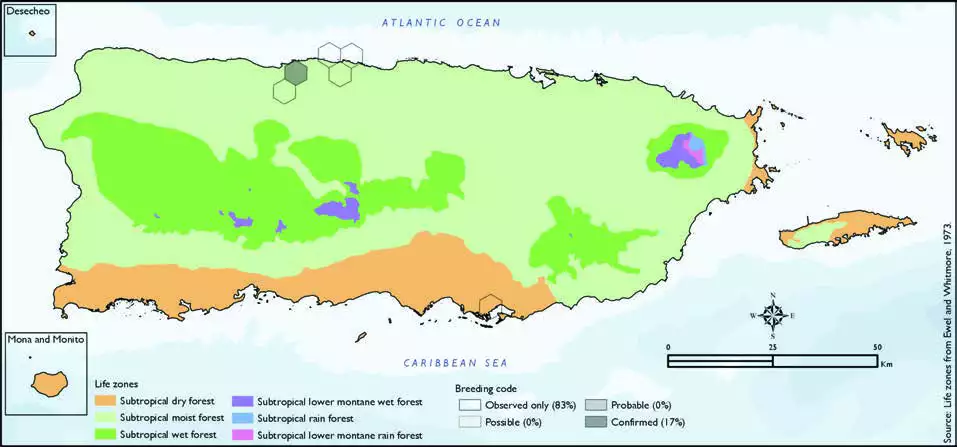White Ibis
Distribution & Habitat
The White Ibis occurs from the Southeastern United States
through northern South America
including the West Indies
(Raffaele and others 1998). It is
described as a rare visitor and
breeder in Puerto Rico (Oberle
2018). No records for this
species are recorded for Vieques
(Gemmill 2015). Before the early
2000s, it was a rare visitor but
has since become established
locally in the north coast near
Arecibo and has expanded east
and west along coastal wetlands.
Habitat includes freshwater
swamps, saltwater lagoons, and
rice fields (Raffaele and others
1998). The atlas fieldwork yielded a total of six records
within six hexagons or 1.2
percent of the 479 total hexagons
(see map). Of the six hexagons
where this species was found,
breeding met the atlas definition
of confirmed in 17 percent
(one) of the hexagons, while
the species was observed in 83
percent (five) of the hexagons
but without evidence of breeding
(see map).White Ibis distribution. The map shows the highest breeding code by hexagon and overlaying the ecological life zones in
Puerto Rico. Note: percentages may not total 100 due to rounding.

Breeding Habits
Previously published reports indicate that the White Ibis
breeds from April to September,
and the nesting is colonial
(Raffaele and others 1998). The
nest is made of twigs and grasses 163White Ibis/Ibis Blancoand is usually constructed high in mangroves above water
(Raffaele and others 1998). Atlas
results show that this species
breeds in June and within the
subtropical moist forest life zone
(see chart). Atlas results show
that this species breeds in the
subtropical moist forest life zone
(100 percent of the hexagons)
(see table and map).
Conservation
The current global population trend of the White Ibis is
described as stable, although
some populations have unknown
trends (Wetlands International
2012). This species is currently
listed as a species of least
concern by the IUCN (BirdLife
International 2016). Locally, this
species is not listed in any of the threatened categories of PRDNER
and USFWS. In Puerto Rico,
the White Ibis has a protected
habitat in land of 25 percent or
6 km2 of the total area covered by the hexagons where evidence
of breeding was found for this
species (24 km2).
Related Species
Family:
threskiornithidae